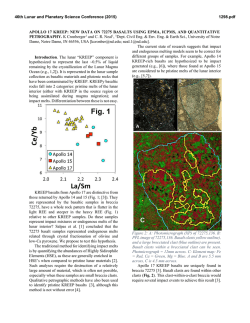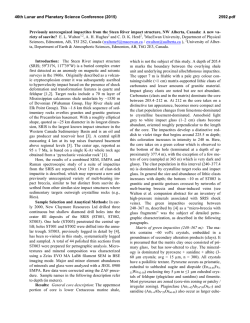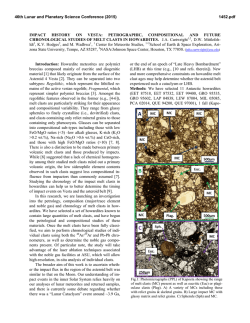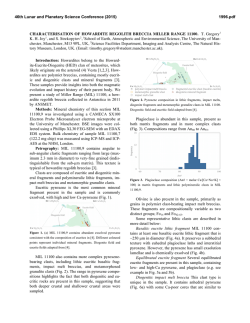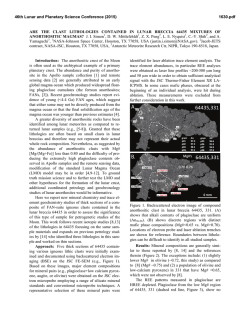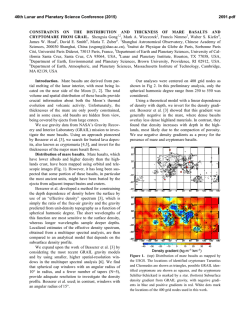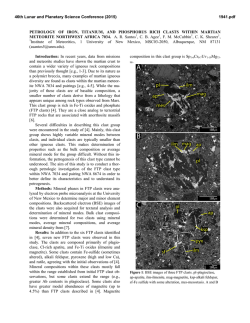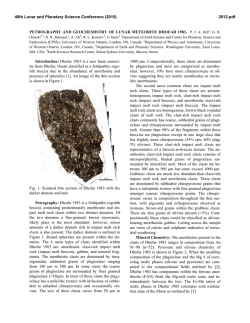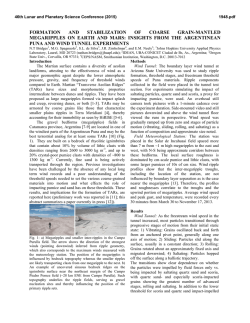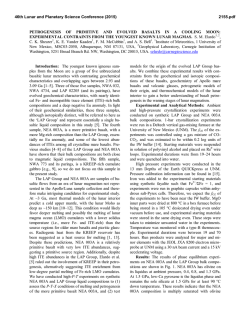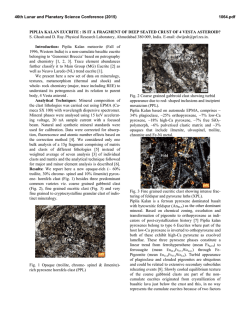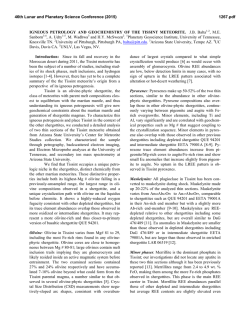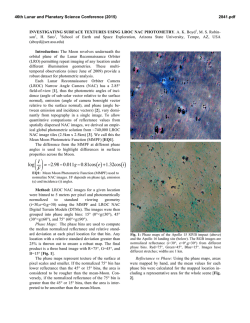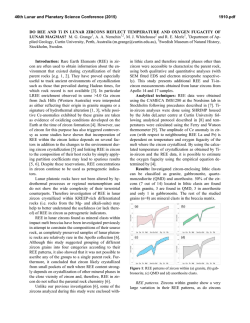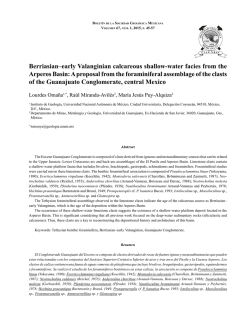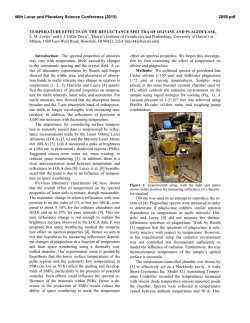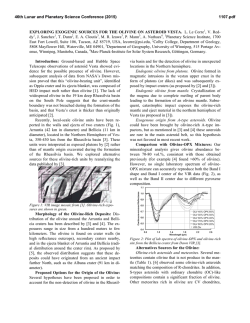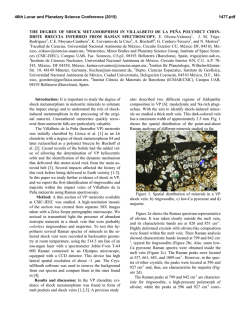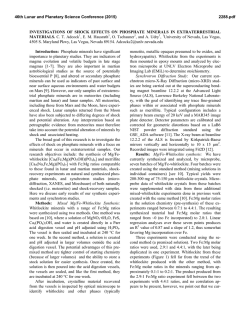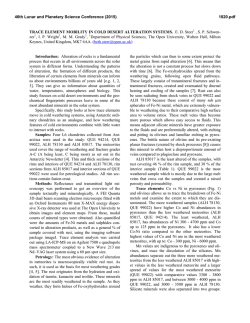
A UNIQUE LUNAR HIGH-TI BASALT DEFINED FROM CLASTS IN
46th Lunar and Planetary Science Conference (2015) 1411.pdf A UNIQUE LUNAR HIGH-TI BASALT DEFINED FROM CLASTS IN APOLLO 16 BRECCIA 60639 Amy L. Fagan1,2,3 and Clive R. Neal1,2, 1Dept. of Civil and Environmental Engineering and Earth Sciences, University of Notre Dame, Notre Dame, IN, 46556; 2NASA Lunar Science Institute; 3Geosciences and Natural Resources Dept., 331 Stillwell Building, Western Carolina University, Cullowhee, NC 28723. ([email protected]; [email protected]) Introduction: The Apollo 16 landing site is dominated by highlands anorthositic material, but rare basaltic samples and glasses have been found as fragments in the regolith or clasts in breccias [1-7]. Basaltic samples from Apollo 16 have a fairly wide compositional range (see [7]), especially in the Ti concentration (i.e., both low- and high-Ti basalts). The Apollo 16 site is devoid of large mare deposits, thus the basalt fragments can be considered exotic to the site; these are of particular interest, as they may represent a basalt type and location on the Moon not previously sampled. Here, we characterize two basalt clasts from Apollo 16 breccia 60639 and re-examine a previously studied clast [1-4] with modern analytical techniques. New mineral and whole-rock chemistry data will augment the small Apollo 16 basalt dataset and will help to quantify the variability of lunar basalts [8]. Sample Description: Sample 60639 is a fragmental polymict breccia containing clasts of basalt, anorthosite, and poikilitic, aphanitic, and glassy impact melt breccias [9]. It was collected as a rake sample near the Lunar Module. The clasts studied here are coarse-grained, feldspathic mare basalts [3] and are composed of approximately 5% olivine, 35% plagioclase, 5-10% ilmenite, 50% pyroxene and accessory spinel minerals [3] (Fig. 1). The mesostasis is Si-rich (Fig. 1) and contains minor sulfide and phosphate phases. The basalt clasts follow the crystallization sequence of early saturation of Plagioclase + AlChromite + Olivine à Cr-ulvöspinel à Ilmenite à Pyroxene [3]. Methods: Mineral Chemistry: The chemical composition of ilmenite, pyroxene, olivine, and plagioclase phases were determined for three thin-sections from 60639 (,2; ,50; and ,52). Major and minor element mineral analyses, as well as the collection of x-ray maps, were conducted using a JEOL JXA-8200 electron microprobe (EMP) at the Washington University (St. Louis) Earth and Planetary Sciences Microanalysis Facility. Trace element data were collected by laser ablation-inductively coupled plasma-mass spectrometry (LA-ICP-MS) using a New Wave UP-213 laser ablation system coupled with a ThermoFinnigan Element2 ICP-MS at the University of Notre Dame’s Midwest Isotope and Trace Element Research Analytical Center (MITERAC). See [10] for more details. Whole Rock Chemistry: Each basalt sample was hand-ground and dissolved in ultrapure HF and HNO3, Fig 1. False color X-ray composite map of a basalt clast in 60639,2 (Red=Fe, Green=Mg, and Blue=Al); a silica phase and circular laser ablation pits appear as black. Px=pyroxene, OL=olivine, Pg=plagioclase, Ilm=ilmenite. in a ratio of 2:1, before being brought to a final volume of ~10 or ~100 g (depending on sample size) in 5% HNO3. This dissolution allows all major (and minor) elements to be quantified, except for SiO2, along with trace elements on the same sample aliquot. The SiO2 concentration was calculated by difference. Major and minor element concentrations were quantified in solution-mode using a Perkin Elmer 3300 XL Optima ICPOptical Emission Spectrometry (ICP-OES) at the University of Notre Dame’s Center for Environmental Science and Technology. Trace element data were collected via solution-mode ICP-MS at MITERAC. Results: Mineral Phase Analyses: Pyroxenes are predominantly augite with subparallel rare-earth element (REE) profiles and Ti/AL ratios ~0.5; some crystals exhibit minor zonation, sometimes to pyroxferroite [3]. Plagioclase is An-rich (avg. An93.5) and, like pyroxene, rims generally have a higher Fe/(Fe+Mg) ratio than cores. Ilmenite has no noticeable major or minor element zoning. Olivine are Fo64-69 and enriched in Cr (≥900 ppm). Whole-rock Analyses: Despite small sample masses (<60 mg), the compositions of the basalt clasts are similar and variances may be explained by relative concentrations of particular phases within separate aliquots. Analyses from the three basalt clasts show them to be high-Ti (7.4 to 7.9 wt% TiO2), high-Al (11.413.4 wt% Al2O3) basalts with ~0.15 to 0.17 wt% K2O (Fig. 2). The REE profiles are enriched relative to chondrites (cf., [11]), subparallel, with a slight concave down shape with a maximum in the middle REE. 46th Lunar and Planetary Science Conference (2015) b Fig 2. Whole-rock comparisons of 60639 basalt clasts with high-Ti basalts from Apollo 11, 12, and 17 missions. Interpretation: Mineral phases are compositionally similar among the three basalt clasts suggesting that they are related. The relatively high TiO2 concentration within the plagioclase confirms that it crystallized before ilmenite. A pyroxene Ti/Al ratio of ~0.5 is also consistent with the crystallization sequence, as Ti and Al are incompatible in both Mg- and Fe-rich pyroxenes [12]. A late-stage olivine crystal has the lowest Ti concentration, suggesting that olivine crystallization continued after ilmenite came on the liquidus. Previous studies have reported data from a single basalt clast from 60639 and noted similarities with basalts from Luna and other Apollo missions [1-3]. The 60639 basalt clasts lie on the lower end of the high-Ti basalt array (cf., [13]), but have relatively high concentrations of Al2O3. Although most major element data are broadly similar to Apollo 11 and 17 high-Ti basalts, the 60639 basalt clasts do not fall consistently 1411.pdf within any single Apollo 11 high-Ti basalt groups defined by [14,15]. For example, the 60639 clasts appear to be similar to Apollo 11 Group B2 and D basalts in terms of Al2O3 and TiO2, whereas they are distinct from the Apollo 17 high-Ti basalts and the Apollo 12 ilmenite basalts (Fig. 2a). The 60639 basalts are compositionally intermediate between the Apollo 11 Group A and Group B1 basalts when considering concentrations of K2O and La (Fig. 2b). The clasts also exhibit relatively low Sc/Sm values (<6) that is similar to Apollo 11 Group A, B1, and B2 basalts, but a lack of pyroxene phenocrysts suggests the low ratio is due to partial melting of a pyroxene-poor source, rather than crystal fractionation. The average La/Hf ratio of the 60639 clasts is 1.48 ± 0.07 suggesting ilmenite fractionation did not dramatically affect these basalts, which is in contrast to that of the Apollo 11 Group A, B2, and D basalts [16]. REE profiles of the basalt clasts are similar to some Apollo 11 Group B3 basalts. A number of similarities exist with the Apollo 11 Group A basalts, suggesting that the 60639 clasts may have also experienced evolution through assimilation of a QMD-like material similar to that of the Group A basalts [15]. Modeling shows assimilation of ~ 7% of a neu-KREEP [17] component can generate the REE profile and K2O concentration seen in the 60639 clasts. Conclusions: The 12-fold mare basalt classification scheme of [13] has 7 groups populated by known samples. The 60639 basalts are the first to fall within the high-Ti/high-Al/high-K group. This, in addition to the lack of consistent similarities with any other highTi basalt group, indicates that the 60639 clasts are a unique type of basalt that has not been previously recognized. The clasts attained this composition through derivation from a relatively pyroxene-poor source followed by assimilation of a QMD-like material. References: [1] E. Dowty et al., (1974), PLPSC., 5th, 431-445. [2] A.V. Murali et al. (1976), LPSC, 7th, 583-584. [3] J.W. Delano (1975), PLPSC 6th, 15-47. [4] Ma M. et al. (1976) 7th PLPSC, 1673-1695. [5] Simon S.B. and Papike J.J. (1987) LPSC, 18th, 922-923. [6] Hughes S.S. and Schmitt R.A. (1988) LPSC, 19th, 515-516. [7] Zeigler et al. (2006), MAPS, 41, 263-284. [8] National Research Council (2007) Scientific Context Explor. Moon. [9] G. Ryder and M. Norman (1980), NASA Cur. Branch Pub. 52, JSC 16904. [10] Fagan A.L. (2012) PhD Dissertation, Univ. Notre Dame. [11] Anders E. and Grevesse N. (1989) Geochim. Cosmochim. Acta, 53, 197-214. [12] Dygert N. et al. (2014) Geochim. Cosmochim. Acta, 132, 170-186. [13] Neal C.R. and Taylor L.A. (1992) Geochim. Cosmochim. Acta, 56, 21772211. [14] Beaty D.W. et al. (1979) PLPSC, 10, 41-75. [15] E.A. Jerde et al. (1994), GCA, 58, 515-527. [16] Neal C.R. et al. (1994) Meteoritics, 29, 349-361. [17] Warren P.H. et al. (1985) Ann. Rev. Earth. Planet. Sci., 13, 201-240.
© Copyright 2026
